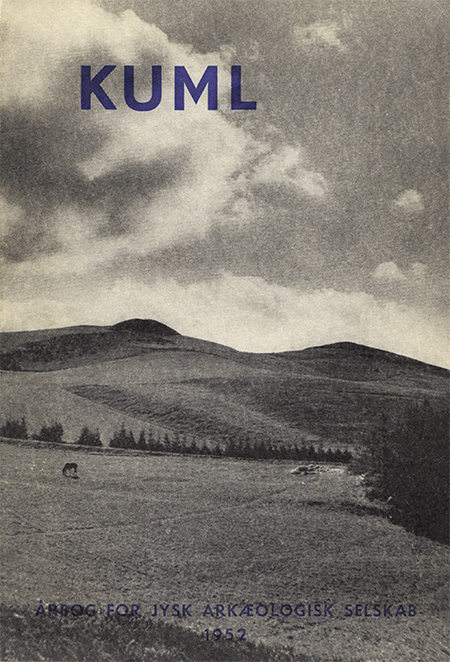Stendyngegrave fra jættestuetid
DOI:
https://doi.org/10.7146/kuml.v2i2.24901Nøgleord:
grav, jættestueResumé
Cairn Burials from the Passage-Grave Period
Among those areas of the Jutland heathland which have only recently and as yet only partially been broken in to cultivation and which have therefore preserved those relics of prehistoric times which of necessity disappear under the plough, one area, the northern part of Østerbølle Parish in Rinds Herred, takes an important place. It is flat and sandy and bas therefore been especially suited to the primitive agriculture of the New Stone Age; and the discovery of graves from all the Neolithic periods shows that it was in fact continuously inhabited from the Dolmen Period, through the Passage-Grave and SeparateGrave Periods, to the Slab-Cist Period.
It was during Professor Gudmund Hatt's exeavation of the Iron Age settlement of Østerbølle that a local landowner, J. Chr. Sørensen, informed him of the discovery, on his land, of "cairns containing flint axes". And the WestHimmerland Museum thereby commenced an investigation of the area which provided an outline of the history of human settlement in the parish, in addition to solving the problem of the mysterious cairns.
In addition to those already discovered four new cairns were now found on a narrow strip of uncultivated heathland. They lay 10-20 meters apart and consisted of low oval heaps of stones covered by sparse heather.
Cairn I (figs. 1 & 2) was 5 by 3 meters in size and 55 cms. high, oval and aligned SE-NW. In the centre was an area free of stones, in the NW end of which was a pit measuring 140 X 65 cms. by 30 cms. deep. No relics were found in this pit but 2 thin-bladed flint axes and a polished flint chisel (fig. 3) came to light in the SE part of the complex.
Cairn II resembled Cairn I completely, except that it was edged on the south by a single row of large stones (fig. 4). It was aligned N-S, measured 5 X 4½ meters and was 50 cms. high. Two pits were found, one in the south end of the central stone-free area, aligned SE-NW and measuring 140 x 85 cms. by 25 cms. deep (fig. 5), and the other under the cairn, aligned N-S and measuring 125 X 50 cms. by 30 cms. deep. No objects were found in this cairn.
Cairn III was aligned SE-NW and had measured approximately 8 by 3½ meters (fig. 6). A pit at the SE end was aligned SE-NW, measured 140 x 70 cms. and was 75 cms. deep, while in the NW end a similar pit measured 120 X 90 x 90 cms. In the soil which filled the latter pit scattered sherds of a thick-walled vessel of Stone Age characteristics were found.
Cairn IV was less compact than the previous cairns and measured E-W 3 meters, N-S 2½ meters and 40 cms. in height (fig. 7). A grave (fig. 8) lay below ground level in the centre, formed like a somewhat irregular slab-cist of stones set on edge. It measured 76 x 34 cms. and was 20 cms. deep. There were no roof slabs, nor did the cairn contain any relics.
Of the four cairns previously found one had measured 7-8 x 1 meters and its stone-free centre had been divided into two compartments of varying size. Two thick-butted axes lay in the east end. The second cairn had measured 2 x 1 meters, had been open at the east end and contained the butt-end of a thick-butted axe. The third had been about 7-8 meters long and had contained 5 thick-butted axes, while the fourth, found on a neighbor's land, had contained one thick-butted axe.
In consideration of the very small number of inhumation graves with passage-grave furniture hitherto found it is tempting to see in this comparatively large group signs of the conservatism of an isolated Stone-Age village.
S. Vestergaard Nielsen
Downloads
Publiceret
Citation/Eksport
Nummer
Sektion
Licens
Fra og med årgang 2022 er artikler udgivet i Kuml med en licens fra Creative Commons (CC BY-NC-SA 4.0).
Alle tidligere årgange af tidsskriftet er ikke udgivet med en licens fra Creative Commons.


